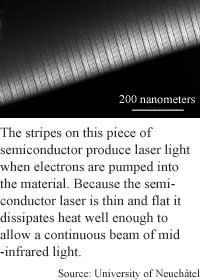
Laser
speeds data through air
By
Eric Smalley,
Technology Research NewsThe dramatic difference in quality between video streamed over the Internet and video played from a DVD is largely due to the relatively slow telephone and cable connections linking individual homes to the Internet's fiber-optic highways and byways. Running fast fiber-optic lines all the way into the home, however, has so far proved too expensive.
But the light pulses that carry digital signals don't have to be confined within fiber optic lines: these laser pulses can also be sent through the open air. The key to fast wireless optical communications is making lasers that produce beams in the mid-infrared portion of the light spectrum, which can carry signals a practical distance through the air, even in bad weather.
Researchers at the University of Neuchâtel in Switzerland have built a continuous-beam mid-infrared laser that operates at room temperature. The laser is made from layers of semiconductor materials that would be relatively easy to build it into computer chips like those used for optical communications.
Using the researchers' infrared laser, it should be possible to beam high-speed data transmissions across several kilometers of open space hundreds of times faster than cable modem speeds, said Mathias Beck, a research associate at the University of Neuchâtel. Such connections, however, would require unobstructed paths.
Mid-infrared lasers have been built before, but in order to produce a continuous light beam they have had to be cooled to very low temperatures. "The major problem was the high current consumption and the huge heat generation during lasing action," said Beck. "That's why this type of laser only worked in pulsed mode at room temperature."
Communications systems made with pulsed lasers have more complicated electronic circuits and require a higher current to drive the laser than systems using continuous laser beams, said Beck. "The electronic system to operate a continuous-wave laser is much easier to fabricate, is smaller and can be portable," he said.
Lasers usually generate light using two opposing mirrors positioned around an active element like a crystal that amplifies the light. The researchers solved the heat problem by reducing the amount of electricity needed to start the laser by 40 percent, making the laser smaller, and embedding the active element completely within the semiconductor indium phosphide, which helps dissipate more heat, said Beck.
Transmitting light in the mid-infrared portion of the electromagnetic spectrum is important because the atmosphere is most transparent to light at two bands of wavelengths in that range. Because water vapor in the air absorbs only a small amount of light at those wavelengths compared to the shorter-wavelength infrared light used in today's wireless optical communications systems, more of the light gets through to the receiver, making for a more efficient communications system, said Beck. "Free-space optical systems based on this type of laser should work at distances of two to three kilometers, even in rain, snow and fog," he said.
The researchers have modulated the laser beam several billion times per second, said Beck. This is equivalent to a data transmission rate that is hundreds of times faster than those of cable modems, which are the fastest consumer Internet connections available.
The mid-infrared laser could also make for more sensitive spectroscopy instruments that can be used for medical diagnostics, pollution detection and controlling chemical and pharmaceutical production processes. Spectroscopy is the process of shining light through a gas and measuring which wavelengths of the light are absorbed by the gas and which pass through. Because substances absorb light at unique sets of wavelengths, it is possible to use spectroscopy to tell what substances are in a gas.
Most molecules absorb specific wavelengths of light within the mid-infrared range, said Beck. "It's therefore also called the 'fingerprint' region of molecules." The researchers' laser could be used to build cheap, portable sensors that can detect a wide range of substances in small amounts, he said.
Continuous laser beams are narrower than pulses of laser light, which is a critical factor for spectroscopy, said Beck. "High selectivity can only be achieved with the narrow line width of the continuous-wave laser," he said.
Most continuous-beam mid-infrared lasers have to be cooled to relatively low temperatures, generally using bulky and expensive cryogenic equipment, said Larry Coldren, a professor of optoelectronics and sensors that the University of California at Santa Barbara. "Operation at room temperature or above is essential to create a practical, low-cost device," he said. Military imaging and targeting, medical diagnostics and pollution sensing are key applications for the laser, he said.
Continuous wave mid-infrared lasers are likely be put to practical use in two to five years, said Beck.
Beck's research colleagues were Daniel Hofstetter, Thierry Aellen and Jérôme Faist of the University of Neuchâtel, and Ursula Oesterle, Marc Ilegems, Emilio Gini and Hans Melchior of the Swiss Federal Institute of Technology. They published their research in the December 20, 2001 online issue of the journal Science. The research was funded by the Swiss National Science Foundation and the Information Society Technologies Programme (IST) of the European Community.
Timeline: 2-5 years
Funding: Government
TRN Categories: Optical Computing, Optoelectronics and Photonics; Internet; Telecommunications; Materials Science and Engineering
Story Type: News
Related Elements: Technical paper, "Continuous Wave Operation of a Mid- Infrared Semiconductor Laser at Room Temperature," Science, December 20, 2001
Advertisements:
January 23, 2002
Page One
Laser speeds data through air
Nanotube array could form chips
Hot spots give away lying eyes
Quantum data compares faster
Artificial crystals change laser colors

News:
Research News Roundup
Research Watch blog
Features:
View from the High Ground Q&A
How It Works
RSS Feeds:
News
Ad links:
Buy an ad link
| Advertisements:
|
 |
Ad links: Clear History
Buy an ad link
|
TRN
Newswire and Headline Feeds for Web sites
|
© Copyright Technology Research News, LLC 2000-2006. All rights reserved.